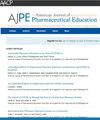Exploring the Feasibility of Implementing Entrustable Professional Activities in Workplace-based Training: Insights from Pharmacy Educators
IF 3.5
4区 教育学
Q1 EDUCATION, SCIENTIFIC DISCIPLINES
引用次数: 0
Abstract
Objective
To explore the feasibility of adapting and implementing pharmacy entrustable professional activities (EPAs) in workplace-based training.
Methods
Pharmacy faculty, experienced workplace-based pharmacy educators and practicing pharmacists representing various practice settings were recruited for focus group interviews to explore their perspectives on the feasibility of incorporating 15 EPAs reflecting entry-level pharmacy practice. Interview questions were derived from the validated Quality of Entrustable Professional Activities (QUEPA) rubric. Participants were also asked to provide their views on the facilitators and barriers to introducing EPAs in workplace-based training.
Results
Five focus groups were conducted with a total of 24 participants between October and November 2023. Four key themes emerged regarding the feasibility of adapting and implementing the 15 EPAs: (1) clarity and measurability of entry-level tasks, (2) limitations and restrictions in EPA implementation, (3) environmental facilitators, and (4) supervisor influence on entrustment decision-making. Participants reported that successful EPA adaptation requires addressing regulatory and contextual barriers, training supervisors in EPA usage, and ensuring EPAs remain adaptable to evolving professional and health care needs.
Conclusion
The validated QUEPA rubric provided a systematic approach to exploring the incorporation of EPA statements in workplace-based training. Participants recognized the potential of EPAs to support curriculum development and expand pharmacists’ scope of practice. Supervisor-dependent influence on entrustment decision-making emerged as a notable factor that could impact the feasibility of EPA adaptation and implementation. Continuous refinement and active stakeholder collaboration are essential for the effective use of EPAs as a supportive educational framework.
探索在工作场所培训中实施可信赖的专业活动的可行性:来自药学教育者的见解。
目的:探讨在工作场所培训中适应和实施药学委托专业活动(EPA)的可行性。方法:招募来自不同实践环境的药学教师、经验丰富的职场药学教育工作者和执业药师进行焦点小组访谈,探讨他们对纳入15个反映初级药学实践的EPAs的可行性的看法。访谈问题来源于经过验证的可信赖专业活动质量(QUEPA)标题。与会者还被要求就在工作场所培训中引入环境保护方案的促进因素和障碍提供他们的观点。结果:在2023年10月至11月期间进行了5个焦点小组,共24名参与者。在调整和实施15项环境保护协议的可行性方面,出现了四个关键主题:(1)入门级任务的清晰度和可衡量性;(2)环境保护协议实施的限制和限制;(3)环境促进因素;(4)监管机构对委托决策的影响。与会者报告说,环境保护措施的成功实施需要解决法规和背景障碍,培训主管如何使用环境保护措施,并确保环境保护措施能够适应不断变化的专业和医疗保健需求。结论:经过验证的QUEPA准则提供了一种探索如何将epa语句纳入工作场所培训的系统方法。与会者认识到EPAs在支持课程发展和扩大药剂师实践范围方面的潜力。管理者对委托决策的依赖影响是影响环境保护适应和实施可行性的显著因素。持续完善和积极的利益相关者合作是有效实施环境影响评估作为一个支持性教育框架的必要条件。
本文章由计算机程序翻译,如有差异,请以英文原文为准。
求助全文
约1分钟内获得全文
求助全文
来源期刊
CiteScore
4.30
自引率
15.20%
发文量
114
期刊介绍:
The Journal accepts unsolicited manuscripts that have not been published and are not under consideration for publication elsewhere. The Journal only considers material related to pharmaceutical education for publication. Authors must prepare manuscripts to conform to the Journal style (Author Instructions). All manuscripts are subject to peer review and approval by the editor prior to acceptance for publication. Reviewers are assigned by the editor with the advice of the editorial board as needed. Manuscripts are submitted and processed online (Submit a Manuscript) using Editorial Manager, an online manuscript tracking system that facilitates communication between the editorial office, editor, associate editors, reviewers, and authors.
After a manuscript is accepted, it is scheduled for publication in an upcoming issue of the Journal. All manuscripts are formatted and copyedited, and returned to the author for review and approval of the changes. Approximately 2 weeks prior to publication, the author receives an electronic proof of the article for final review and approval. Authors are not assessed page charges for publication.

 求助内容:
求助内容: 应助结果提醒方式:
应助结果提醒方式:


